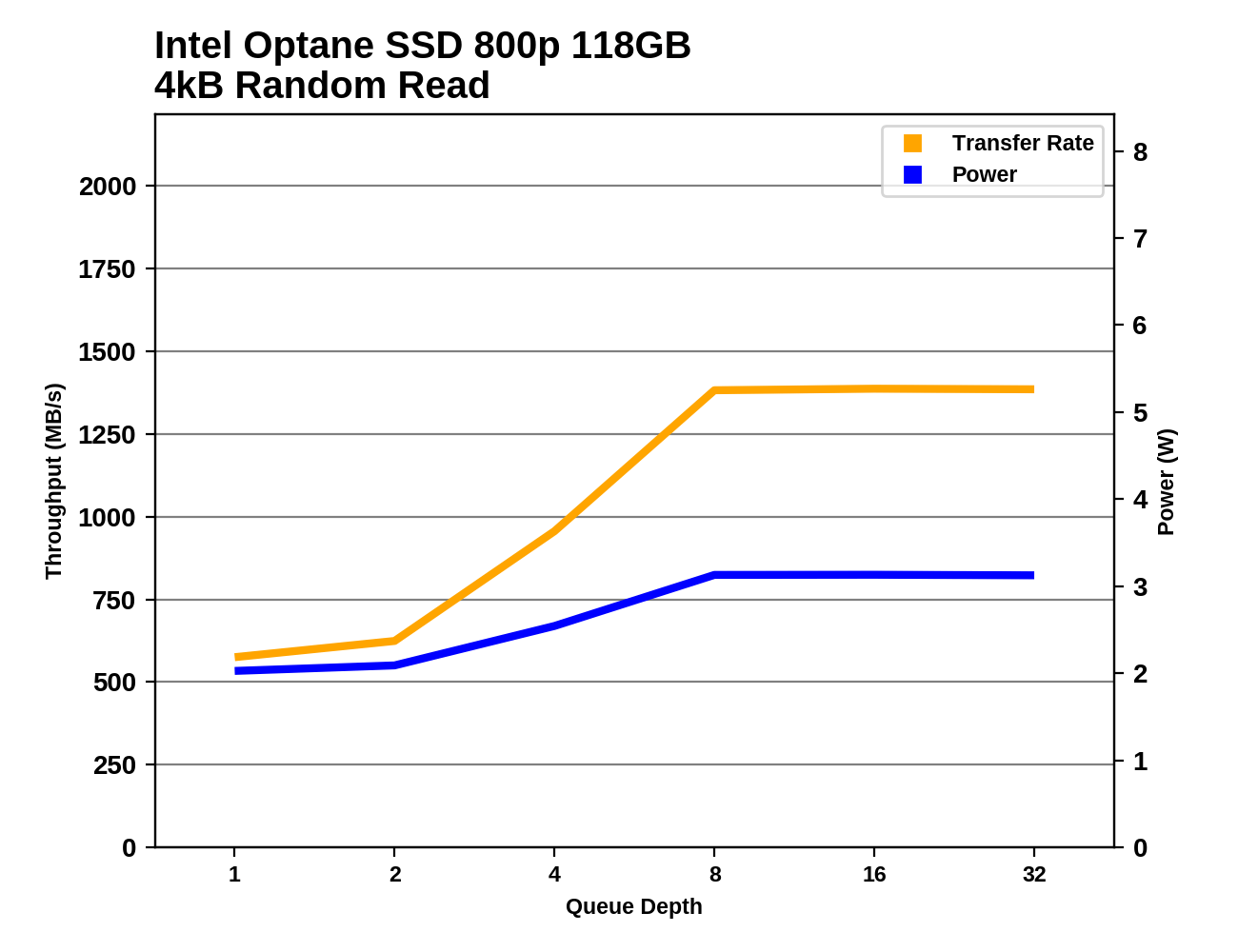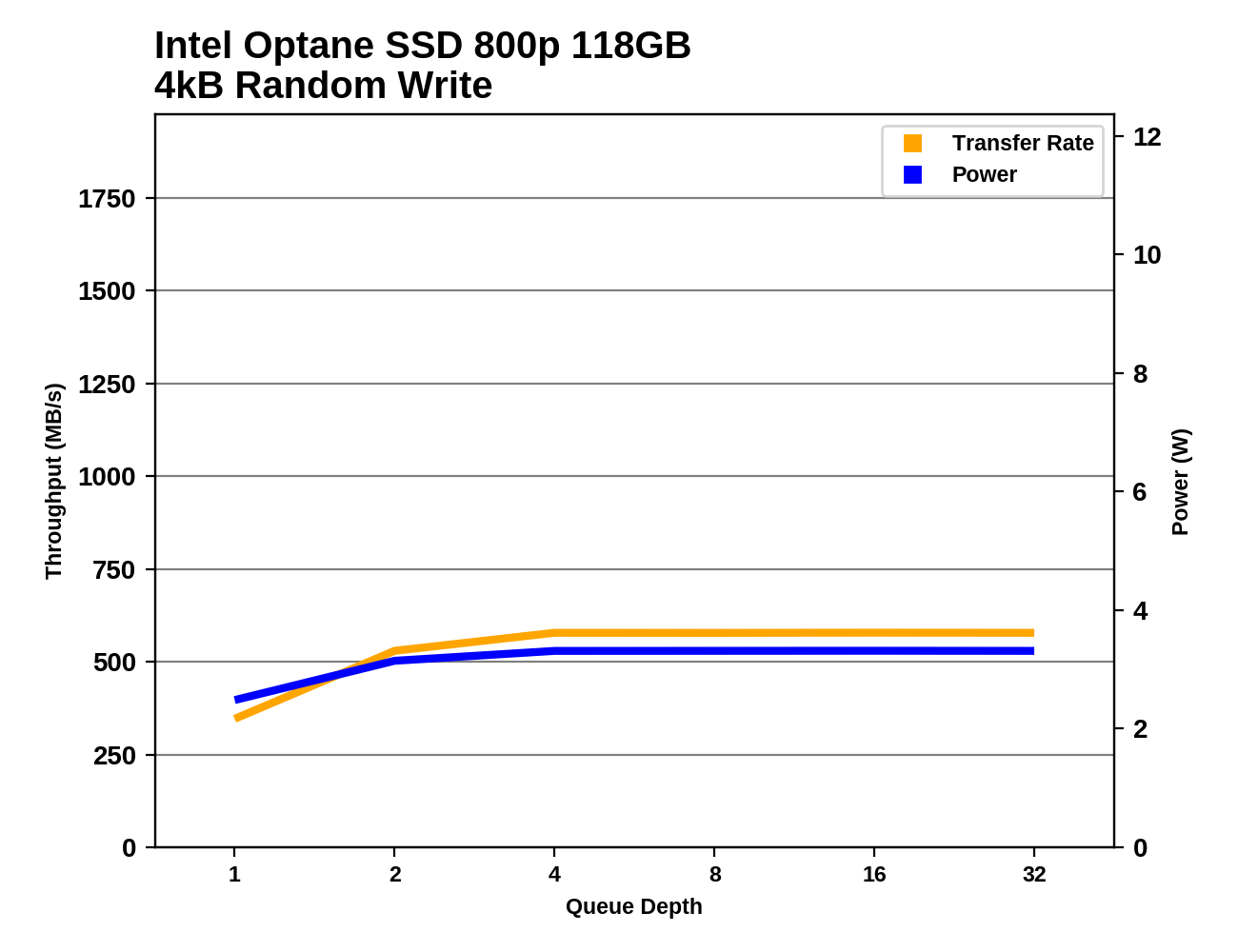The Intel Optane SSD 800p (58GB & 118GB) Review: Almost The Right Size
by Billy Tallis on March 8, 2018 5:15 PM ESTRandom Read Performance
Our first test of random read performance uses very short bursts of operations issued one at a time with no queuing. The drives are given enough idle time between bursts to yield an overall duty cycle of 20%, so thermal throttling is impossible. Each burst consists of a total of 32MB of 4kB random reads, from a 16GB span of the disk. The total data read is 1GB.

Like the Optane Memory M.2, the Optane SSD 800p has extremely high random read performance even at QD1. The M.2 drives even have a substantial lead over the much larger and more power-hungry 900p and its enterprise counterpart P4800X. Even the best flash-based SSDs are almost an order of magnitude slower.
Our sustained random read performance is similar to the random read test from our 2015 test suite: queue depths from 1 to 32 are tested, and the average performance and power efficiency across QD1, QD2 and QD4 are reported as the primary scores. Each queue depth is tested for one minute or 32GB of data transferred, whichever is shorter. After each queue depth is tested, the drive is given up to one minute to cool off so that the higher queue depths are unlikely to be affected by accumulated heat build-up. The individual read operations are again 4kB, and cover a 64GB span of the drive.

The Optane SSDs continue to dominate on the longer random read test, though the addition of higher queue depths allows the 900p to pull ahead of the 800p.

With extremely high performance but lacking the high power draw of the enterprise-class 900p, the Optane SSD 800p is by far the most power efficient at performing random reads.
 |
|||||||||
The Optane SSD 800p starts out in the lead at QD1, but its performance is overtaken by the 900p at all higher queue depths. The flash-based SSDs have power consumption that is comparable to the 800p, but even at QD32 Samsung's 960 PRO hasn't caught up to the 800p's random read performance.
Random Write Performance
Our test of random write burst performance is structured similarly to the random read burst test, but each burst is only 4MB and the total test length is 128MB. The 4kB random write operations are distributed over a 16GB span of the drive, and the operations are issued one at a time with no queuing.

Flash-based SSDs can cache and combine write operations, so they are able to offer random write performance close to that of the Optane SSDs, which do not perform any significant caching. Where the 32GB Optane Memory offered relatively poor burst random write performance, the 800p is at least as fast as the best flash-based SSDs.
As with the sustained random read test, our sustained 4kB random write test runs for up to one minute or 32GB per queue depth, covering a 64GB span of the drive and giving the drive up to 1 minute of idle time between queue depths to allow for write caches to be flushed and for the drive to cool down.

When higher queue depths come into play, the write caching ability of Samsung's high-end NVMe SSDs allows them to exceed the Optane SSD 800p's random write speed, though the 900p still holds on to the lead. The 800p's improvement over the Optane Memory is even more apparent with this longer test.

The power efficiency of the 800p during random writes is pretty good, though Samsung's top drives are better still. The Optane Memory lags behind on account of its poor performance, and the 900p ranks below that because it draws so much power in the process of delivering top performance.
 |
|||||||||
The Samsung 960 PRO and the Intel Optane SSD 900p show off at high queue depths thanks to the high channel counts of their controllers. The Optane SSD 800p doesn't have much room for performance to scale beyond QD2.










116 Comments
View All Comments
beginner99 - Friday, March 9, 2018 - link
Exactly. Anything below 240GB is not a workable solution nowadays. I remember my first intel g2 80GB. constant micro-managing where to put files and which app gets to be on the ssd and which not. Or for my parents I back then got them a 64 gb drive. When the win 10 update came it was not possible to update because updating windows 7 to 10 requires more than 64gb.Calin - Friday, March 9, 2018 - link
I do use a 120GB SSD on my desktop, and it works good enough with a 2TB hard drive. I even use a 90% partition, as early SSDs had performance problems when close to full.sharath.naik - Thursday, March 8, 2018 - link
was rapid mode tried on Samsung drives?. not sure with a large enough ram the difference in random performance would matter that much.Billy Tallis - Thursday, March 8, 2018 - link
Half the test suite is run on Linux, so Rapid Mode isn't an option. And in general, I don't approve of third-party software that second-guesses the decisions made by core parts of the OS like the virtual memory system—especially not when those tools put user data at risk without being absolutely clear about what they're really doing.eddieobscurant - Friday, March 9, 2018 - link
Billy , do you have any news on micron's QuantX ?Dragonstongue - Thursday, March 8, 2018 - link
Intel and Micron (IM) joint venture, Intel "branded" as Optane either way is 3D XPoint..far as I understood Micron decided to "drop it" so is Intel going about it all on their own, was Unity Semiconductors who was bought out by Rambus 2012, that likely not a good thing either (they) RB seem more prevalent to sue people vs making a tangible product everyone wants (IMO)the above 3d x, optane whatever seems like another thing that "on paper" seems like would be a decent thing, but, the price factor puts it into a "there are better options available" that offer similar performance or at the very least substantially better $/gb value.
I think that is what Micron was seeing, no real way to get the "value" out of it without charging too high a price to make it market worthwhile for them and consumer, Intel is their own fish and they always (again IMO) charge substantial price for a "do we really need this" type product (like Nvidia) cut corners or cut down performance that could have been, but still want top dollar, and "next year" come out with a more full fat version (that should have been the previous year) and want more $ for the "upgrade" planned obsolescence/upgrade path.
for a loose example, Samsung 950 EVO M.2 250gb (pro faster but ofc more pricey)
I see available for ~$160 CAD
read/write 3200/1900
QD1 Thread
Random Read: 14,000 IOPS
Random Write: 50,000 IOPS
QD32 Thread
Random Read: 380,000 IOPS
Random Write: 360,000 IOPS
their "power draw" and latency do not seem to be praiseworth either, so it still leads me to the same question "why bother"...also, I really wish M.2 drives were maybe a toned down speed version so it could be "less expensive" here I thought that by going smaller and smaller node and going from SLC to MLC to 3d etc price would drop and drop while performance would go up and up, seems that the only real thing that has changed is the less on the "board" the further they crank the speed give smaller capacity and increase the price *facepalm*
Lolimaster - Friday, March 9, 2018 - link
10x less latency15x faster in QD1r
4X faster in QD1w
Adramtech - Saturday, March 10, 2018 - link
Micron has no plans to drop QuantX and are providing an update at their May tech conference.shabby - Thursday, March 8, 2018 - link
Leave it to intel to artificially cripple a product on purpose, who does this?boeush - Thursday, March 8, 2018 - link
Seems to me, if you really want supper-fast, low-latency high-endurance random read/write at low QD and capacities ~128GB for a lot of $$$, then just get a bunch of RAM and a UPS (to prevent data loss in case of power failure.). No SSD technology will ever beat good ol' RAM in terms of performance. In this case, for mass storage you just need fast sequential reads and writes so you can quickly map your filesystem to/from RAM on system startup/shutdown, respectively...In light of which, until Intel comes out with their next-gen Optane at 512 GB+ capacities in M.2 package, the current product feels like a solution on search of a problem